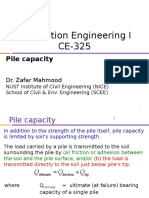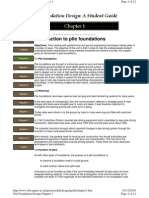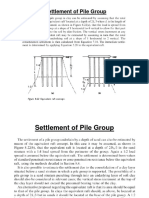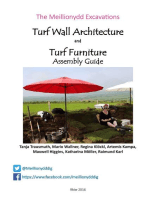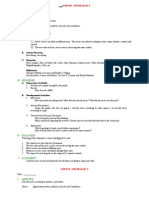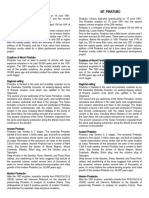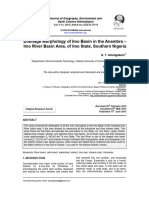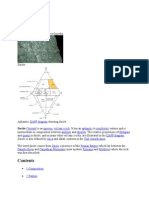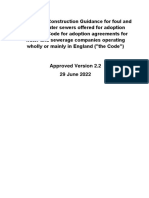0 ratings0% found this document useful (0 votes)
13 viewsPile Foundations Ii - chp2
Uploaded by
Uveys kavakliCopyright
© © All Rights Reserved
We take content rights seriously. If you suspect this is your content, claim it here.
Available Formats
Download as PDF, TXT or read online on Scribd
0 ratings0% found this document useful (0 votes)
13 viewsPile Foundations Ii - chp2
Uploaded by
Uveys kavakliCopyright
© © All Rights Reserved
We take content rights seriously. If you suspect this is your content, claim it here.
Available Formats
Download as PDF, TXT or read online on Scribd
You are on page 1/ 39
PILE FOUNDATIONS II
By Assoc. Prof. Dr. Tuğba Eskişar
Spring Semester 2017
Lecture Notes-Chapter 2
2. Action of Piles
2.1 Friction Piles
Along the surface of these piles considerable
frictional forces may develop even in very soft
layers after settlement.
• Pure friction piles driven into deep strata of
uniform consistency
• This is also a friction pile, downward
movement of pile is not enough to develop
frictional resistance between A & B.
• Generally the frictional force (Skin Friction ) at
the surface of a friction pile acts upward.
• The direction of the skin friction is that of the
movement of the adjacent soil mass with
respect to the pile.
• If the pile moves
downward under the
action of the load, this
means that the relative
motion of the soil mass
is upward, and the skin
friction develops
upward.
• If the pile is pulled out,
the frictional resistance
acts downward.
• The frictional resistance
acts also downwards if
the adjacent soil mass
consolidates (Negative
Skin Friction –NSF).
An example video
• Skin Friction Principle in Burj Al Arab Ground
Foundation
• https://youtu.be/Lxm5PgK3C80
• The skin friction depends on the:
• Type of soil,
• Shape of pile,
• Surface texture of pile,
• Time interval between driving and loading.
• Skin friction cannot be bigger than the shear
strength of the surrounding soil, otherwise
shearing will be in the soil immediately next to
the pile, not between the pile and soil.
• Consider a friction pile driven
into clay.
• Squares 1&2 are elements
within the soil.
• 2𝜋𝑅1 𝑠1 ≅ 2𝜋𝑅2 𝑠2 ≅ 2𝜋𝑅3 𝑠3
• If shearing stress s1 > skin
friction, then shearing is
between pile & soil (adhesion
is overcome).
• If s1 < skin friction & s2 > shear
strength of soil, then shear
strength of soil is overcome).
Skin friction values (Terzaghi & Peck)
Soil Skin Friction (kN/m2)
Loose sand 25
Dense sand 100
Soft clay & silt 10-30
Sandy silt 20-50
Stiff clay 40-100
• The skin friction along a pile driven into sand
increases with depth.
• The skin friction along a pile driven into clay is
almost independent of depth.
Factors affecting skin friction
• Soil type, soil type, soil type
• SF increases with grain size, good grading,
compaction
• SF decreases with increasing moisture content
in clays
More…
a. Time Factor and Skin Friction
• Friction piles driven into soft clay show a
considerable increase in skin friction after a
few days.
• In case of driven pile, a loss of strength occurs
as a result of disturbance due to vibration of
driving. Thixotropy is defined as gaining of
shear strength after driving disturbance when
piles are left for some duration.
A case history
• Soft clay deposit (LL = 37-
45%, PL = 20-22%, n
LL)
• 300*300 mm concrete
piles (25 m long)
• During pile driving the soil
became almost liquid,
practically having no
friction at all.
• Within a month, SF value
increased to more than
three times of its initial
value!
• Practical information only for preliminary
investigations!
• Ultimate value of SF =(UCS =qu)/2
b. Pile Characteristics and Skin Friction
• The unit skin friction value of a square shaped
pile 3/4* the unit skin friction value of a
round pile where, D=a D
a
• The taper has no effect if riction piles are
driven into soft – medium clays.
• This is taper
• In sands, however, tapered piles show
considerable higher bearing capacities than
cylindirical piles.
• In general, surface texture of piles has no great
influence on the bearing capacity. On the other
hand, uncased-cast-in place concrete piles have
greater unit skin friction value than precast
concrete piles have.
• Untreated timber friction piles indicate excellent
adhesion between the pile and soil.
• Evaluation of mobilized skin friction along a
pile is a complex problem and is influenced by
a large number of variables such as the
method of construction, installation of piles,
type of loading, etc.
• Until now, a single friction pile was
considered. In practice, however, piles are
driven to form a group.
• Behavior of of a single friction pile and
another pile in a group of friction piles may be
very different whenever their load carrying
capacities are concerned.
• In a group of piles, the bulb of pressure of
individual piles merge to form a single bulb of
pressure.
• The vertical pressure
intensity at the tip of
piles >>>>>> The vertical
pressure intensity at the
tip of a single pile!
• Therefore, if all piles are
loaded with equal loads,
then the center pile will
tend to settle more than
a single pile!
• The safe bearing value of the group of three piles
≠ 3* safe bearing load of one pile! Group action!
• Just like
• Speed of one horse = 40km/h
• *8 ≠ aaaaaaaaaaaaaaaaa 320 km/h!!!
• Because there is less soil supporting the group
than there would be under three individual and
widely seperated piles.
• Foundation width and
pile length has a great
influence on the bulb of
pressure and
consequently the
bearing capacity of a
group of friction piles.
• The shortcoming of testing a single pile
2.1 End-Bearing Piles
They transfer the applied load through their tips
on a firm strata or rock.
They cannot settle, therefore no frictional
resistance can develop in soft compressible
layers.
• All the load is carried by
the tip.
• They should be strong
as columns.
• Tips should not crush.
Pressure distribution is
at the tips.
• No bulb of pressure in
soft layers.
• Overlapping of bulbs of pressure doesnot
cause any serious deformation in hard strata
or rock.
• The bearing capacity of pile group = number
of piles* bearing capacity of a single pile
• On the other hand, if the loads on piles are
extremely heavy and/or bearing rock is soft,
weathered and fractured then the group
action should be considered.
How long?
Buckling of piles
• End-bearing piles sholud
be strong as columns and
they need lateral support
in the soil.
• If unsupported lengths of
piles above ground exist,
• If the soil is in a liquid
state,
• then buckling must be
checked.
2.3 Negative Skin Friction (NSF)
• Negative skin friction is a downward force
acting on the piles due to relative movement
between the piles and the surrounding
compressible soil.
The possibility of NSF should be
investigated,
• When piles are driven
through compressible
soils to a hard layer and
• the site has a new fill
or
• GWT is lowered
(increase of eff. unit
weight!)
• The same downward drag force may also
develop if end-bearing piles are driven
through a soft layer which was not yet
consolidated under its own weight before pile
driving.
• If friction piles are
driven into a deep
compressible soil
deposit, there will be no
relative movement due
to the weight of a new
fill, because the piles
will settle with the
surrounding soil, and
therefore no NSF will
develop.
• NSF may cause frequent harmful settlements.
• So, how to evaluate NSF?
Single pile
• R=Q+W+*D*Df*s
Where,
s=shear resistance of soil
W= weight of single pile
D=diameter of pile
Df=driven length of pile
Pile group
• R=Q + P*Df*s + *Df*A
or
• R=W + n**D*Df*s
Whichever is smaller
Where,
=unit weight of soil
A=area enclosing all the
piles
P=perimeter of the area
n=number of piles in group
2.4 Relations Between Driving
Resistance and Depth
• Pile driving record = number of blows per unit
length of penetration is valuable.
You might also like
- How to Build a Global Model Earthship Operation I: Tire WorkFrom EverandHow to Build a Global Model Earthship Operation I: Tire WorkNo ratings yet
- Reinforced Concrete Grade Beams, Piles & Caissons: A Practical Guide for Hillside ConstructionFrom EverandReinforced Concrete Grade Beams, Piles & Caissons: A Practical Guide for Hillside ConstructionNo ratings yet
- 4-1 AFE Unit - 2 Pile Foundation Notes-1No ratings yet4-1 AFE Unit - 2 Pile Foundation Notes-120 pages
- Foundation Engineering For Difficult SubsoilConditionsNo ratings yetFoundation Engineering For Difficult SubsoilConditions3 pages
- Skin Friction On Piles at The New Plblic Works Central Laboratory - 11No ratings yetSkin Friction On Piles at The New Plblic Works Central Laboratory - 1170 pages
- Chapter 5 Deep Foundations DR Jorge A. Prieto-S, MSC, PHD, PengNo ratings yetChapter 5 Deep Foundations DR Jorge A. Prieto-S, MSC, PHD, Peng36 pages
- Spacing and Skin Friction in Pile Group Construction - The ConstructorNo ratings yetSpacing and Skin Friction in Pile Group Construction - The Constructor5 pages
- 035 - CE8591, CE6502 Foundation Engineering - 2 marks QuestionsNo ratings yet035 - CE8591, CE6502 Foundation Engineering - 2 marks Questions26 pages
- Introduction To Pile Foundations: Pile Foundation Design: A Student GuideNo ratings yetIntroduction To Pile Foundations: Pile Foundation Design: A Student Guide12 pages
- Settlement of Pile Group, Lec-5r (Compatibility Mode)No ratings yetSettlement of Pile Group, Lec-5r (Compatibility Mode)13 pages
- The Influence of Negative Skin Friction On Piles and Pile GroupsNo ratings yetThe Influence of Negative Skin Friction On Piles and Pile Groups7 pages
- Pressure, Resistance, and Stability of Earth American Society of Civil Engineers: Transactions, Paper No. 1174, Volume LXX, December 1910From EverandPressure, Resistance, and Stability of Earth American Society of Civil Engineers: Transactions, Paper No. 1174, Volume LXX, December 1910No ratings yet
- Tractor Ploughing Manual, The, 2nd Edition: The Society of Ploughman Official HandbookFrom EverandTractor Ploughing Manual, The, 2nd Edition: The Society of Ploughman Official HandbookNo ratings yet
- Instructions on Modern American Bridge BuildingFrom EverandInstructions on Modern American Bridge BuildingNo ratings yet
- Strength Of Beams, Floor And Roofs - Including Directions For Designing And Detailing Roof Trusses, With Criticism Of Various Forms Of Timber ConstructionFrom EverandStrength Of Beams, Floor And Roofs - Including Directions For Designing And Detailing Roof Trusses, With Criticism Of Various Forms Of Timber ConstructionNo ratings yet
- Rock Blasting - A Practical Treatise On The Means Employed In Blasting Rocks For Industrial PurposesFrom EverandRock Blasting - A Practical Treatise On The Means Employed In Blasting Rocks For Industrial PurposesNo ratings yet
- Drainage Morphology of Imo Basin in The Anambra - Imo River Basin Area, of Imo State, Southern NigeriaNo ratings yetDrainage Morphology of Imo Basin in The Anambra - Imo River Basin Area, of Imo State, Southern Nigeria11 pages
- Full Download Introduction to Mineralogy and Petrology 2nd Edition Swapan Kumar Haldar - eBook PDF PDF DOCX100% (4)Full Download Introduction to Mineralogy and Petrology 2nd Edition Swapan Kumar Haldar - eBook PDF PDF DOCX59 pages
- English Vocabulary in Use - Pre-Intermediate and Intermediate Chap 6 and Chap 7No ratings yetEnglish Vocabulary in Use - Pre-Intermediate and Intermediate Chap 6 and Chap 74 pages
- International Journal of Botany Studies Role of Organic Colloids in Soil: A ReviewNo ratings yetInternational Journal of Botany Studies Role of Organic Colloids in Soil: A Review6 pages
- Imperial - Gazetteer - of - India Vol.01 1909 Ia Tpo PDFNo ratings yetImperial - Gazetteer - of - India Vol.01 1909 Ia Tpo PDF595 pages
- SSG Appendix C - Design and Construction Guidance v2-2No ratings yetSSG Appendix C - Design and Construction Guidance v2-2212 pages
















